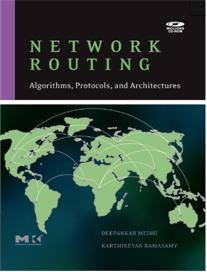| |
|
|
Gutting the book
Just wanted to make sure that you didn't read the header as
"getting" the book.
So, first, what's 'gutting' a book? To quote: "Gutting a book means
quickly establishing the book's thesis (i.e. the main point the
author is trying to make), together with the main lines of argument
and the main evidence used to support those arguments" (more).
Obviously, as the authors, we do a have a theme, a thesis; this is summarized
below. Certainly, as a reader, you make the final decision on how
you want to gut this book.
Network routing can be broadly categorized into Internet routing,
PSTN routing, and telecommunication transport network routing. We
systematically consider these routing paradigms, as well as their
interoperability. we discuss how algorithms, protocols, analysis,
and operational deployment impact these approaches. A unique feature
of the book is consideration of both macro-state and micro-state in
routing; that is, how routing is accomplished at the level of
networks and how routers or switches are designed to enable
efficient routing.
In reading this book, we hope the reader will learn about 1) the
evolution of network routing, 2) the role of IP and E.164 addressing
in routing, 3) the impact on router and switching architectures and
their design, 4) deployment of network routing protocols, 5) the
role of traffic engineering in routing, and 6) lessons learned from
implementation and operational experience. This book explores the
strengths and weaknesses that should be considered during deployment
of future routing schemes as well as actual implementation of these
schemes. It allows the reader to understand how different routing
strategies work and are employed and the connection between them.
We use numerous
real-world examples to bring the material alive.
Features & Benefits
- Bridges the gap between theory and practice in network routing, including the fine points of implementation and operational experience
- Routing in a multitude of technologies discussed in practical detail, including, IP/MPLS, PSTN, and optical networking
- Routing protocols such as OSPF, IS-IS, BGP presented in detail
- A detailed coverage of various router and switch architectures
- A comprehensive discussion about algorithms on IP-lookup and packet classification
- Accessible to a wide audience due to its vendor-neutral approach
- CD-ROM with bonus chapters on advanced topics
|

